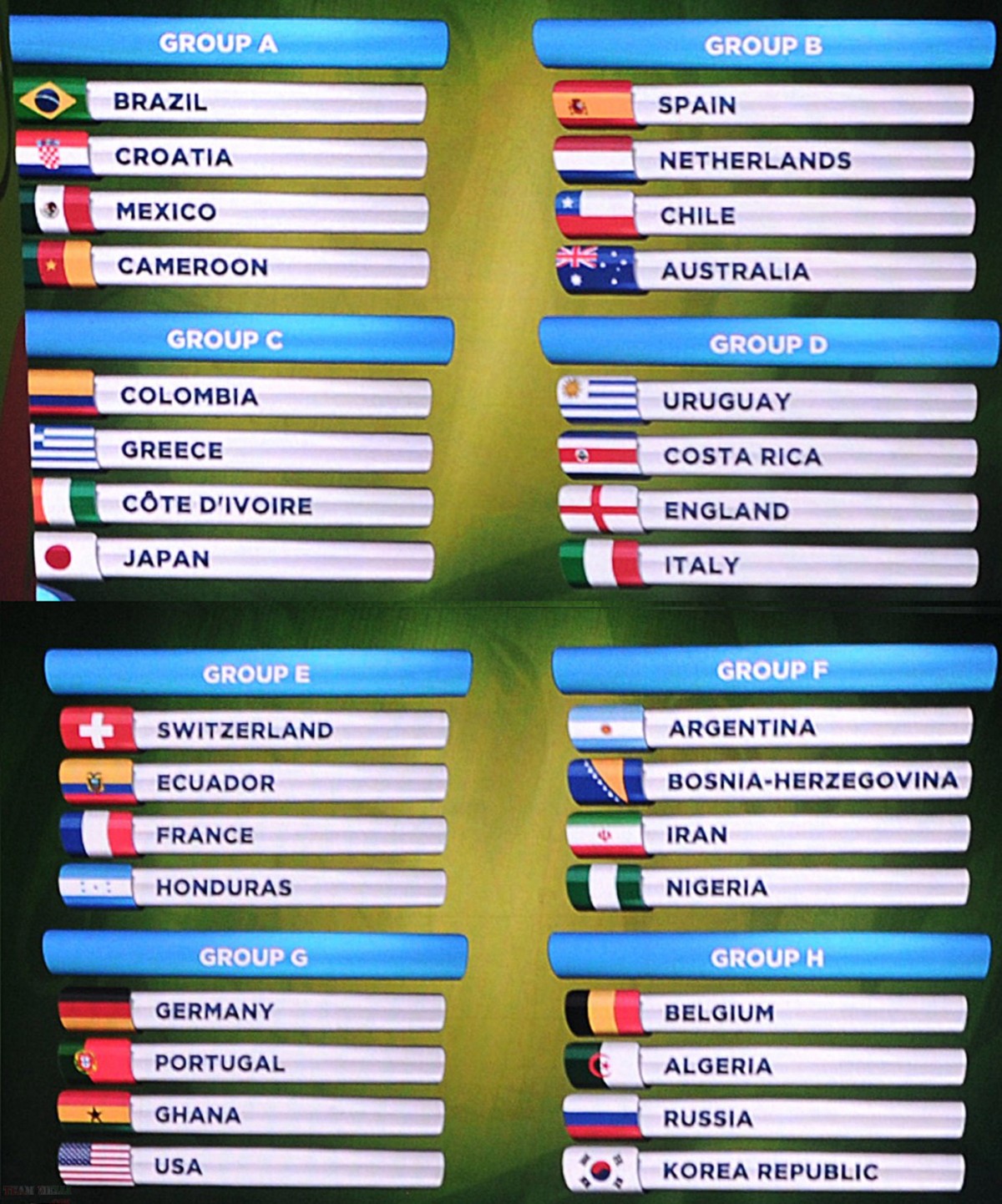[tabs]
[tab title=”News”]

The adidas brazuca, the Official Match Ball for the 2014 FIFA World Cup Brazil™, was given a fittingly spectacular launch on Tuesday 3 December.
The iconic Parque Lage in Rio de Janeiro provided a picturesque venue, while a breathtaking 3D light projection show wowed attendees including former Netherlands international Clarence Seedorf and Brazil world champion Cafu.
[divider]
World Cup Draw

In the centre of Rio de Janeiro, the then capital of Brazil, the Conference Hall of Itamaraty Palace was the venue chosen for the delegations from 14 countries to attend the draw for the group stage of the fourth FIFA World Cup™.
On the afternoon of 22 May 1950, a significant proportion of a planet that was still nursing the wounds left by the Second World War turned its attentions to the silver globe that contained 12 numbered balls. Each one represented one of the teams involved in the draw. Some had come through qualification rounds, like the European, Asian and Central American nations, while others had been invited, as was the case of the South American countries.
Brazil, England, Italy and Uruguay had been nominated as seeds by the Brazilian Sports Confederation, and confirmed by FIFA’s Organising Committee, and as such would not be among the balls that would be drawn. The seeds would be placed in four different groups, which when the tournament kicked off were comprised as follows: two contained four teams, one three and a fourth group with just two teams.
The balls were numbered as follows: (1) Bolivia; (2) Chile, (3) Spain; (4) United States of America; (5) France (6) India; (7) Yugoslavia; (8) Mexico; (9) Paraguay; (10) Sweden; (11) Switzerland and (12) a team to be defined.
The 12th team vacancy was caused by the fact that Turkey, who had successfully negotiated European qualification, had dropped out of the World Cup. Portugal were invited to take their place, but also dropped out of the competition.
As well as diplomatic representatives of 14 teams – the Bolivians did not attend the draw – journalists, photographers and radio reporters were also present in the Itamaraty hall. They were all anxious to report on the fate of their teams and spoke loudly in several languages, making for a wonderfully bizarre confusion.
Silence fell when the Brazilian Minister for Foreign Affairs, Raul Fernandes, pulled the lever of the draw globe, and the first ball rolled out.
“Number seven” was shouted out loud, and the first opponents of Brazil, the seeded team in Group 1, were known. It was Yugoslavia.
Shortly afterwards, the next announcement from the minister: “Number three for Group 2.” It was Spain, who had been drawn in England’s group.
The balls continued to be taken out of the main globe until the draw was complete:
Group 1: Brazil, Yugoslavia, Mexico and Switzerland
Group 2: England, Spain, USA and Chile
Group 3: Italy, Sweden, Paraguay and India
Group 4: Uruguay, France, Bolivia and a team to be defined.
That was the result of the first group draw for a FIFA World Cup held in Brazil, which would begin one month and two days later.
The groups would subsequently be modified. After Turkey and Portugal had both dropped out, India followed suit. Their players refused to take part in the tournament because they were forbidden from playing barefoot. France also dropped out in protest of an itinerary that would have involved a journey of 3,500km between one match and the next one.
[/tab]
[tab title=”Qualification”]
There is no changes with regard to the allocation of places at Brazil 2014. As the FIFA confirmed at the beginning of March, Europe will receive 13 places, Africa 5,South America 4.5, Asia 4.5, North, Central America and Caribbean 3.5 and Oceania 0.5.
Asian Zone Competition
5 teams which fared the best in the last FIFA World Cup received a bye for Rounds 1 and 2 of the competition. The lowest rank teams were drawn to play in round one on a home and away knock out system. In Round Two , a similar Knock out system was played where Team Melli faced Maldives Islands and the Third round was drawn in Rio on 30th July.This round consists of 5 groups of four teams each. The winner and runner up of each group will qualify for round 4 which will consist of two groups of 5 Teams. Two top team qualify for the World Cup finals.
Round 2
| Date | Comp. | H / A / N | Final score | Stadium | Attendance | |
| 28.07.2011 | World Cup Qualifier | A | Maldives | 1 – 0 | Rasmee Dhandu National Stadium , Male | 7000 |
| 23.07.2011 | World Cup Qualifier / Preliminary Round | H | Maldives | 4 – 0 | Azadi Stadium , Tehran | 15000 |
Round 3
|
#
|
Date
|
Match
|
Venue
|
Result
|
|
1
|
02 September 2011
|
Iran-Indonesia
|
Azadi Stadium , Tehran
|
|
|
2
|
02 September 2011
|
Bahrain-Qatar
|
National Stadium, Riffa
|
|
|
3
|
06 September 2011
|
Indonesia-Bahrain
|
Gelora Bung Karno Stadium , Jakarta
|
|
|
4
|
06 September 2011
|
Qatar-Iran
|
Al-Sadd Stadium , Doha
|
|
|
5
|
11 October 2011
|
Indonesia-Qatar
|
Gelora Bung Karno Stadium , Jakarta
|
|
|
7
|
11 November 2011
|
Qatar-Indonesia
|
Al-Sadd Stadium , Doha
|
|
|
8
|
11 November 2011
|
Bahrain-Iran
|
National Stadium , Riffa
|
|
|
9
|
15 November 2011
|
Indonesia-Iran
|
Gelora Bung Karno Stadium , Jakarta
|
|
|
10
|
15 November 2011
|
Qatar-Bahrain
|
Al-Sadd Stadium , Doha
|
|
|
11
|
29 February 2012
|
Iran-Qatar
|
Azadi Stadium , Tehran
|
2-2
|
|
12
|
29 February 2012
|
Bahrain-Indonesia
|
National Stadium, Riffa
|
10-0
|
[divider]
Final standing
| Team | GP | W | D | L | GF | GA | +/- | Pts |
| Iran | 6 | 3 | 3 | 0 | 17 | 5 | 12 | 12 |
| Qatar | 6 | 2 | 4 | 0 | 10 | 5 | 5 | 10 |
| Bahrain | 6 | 2 | 3 | 1 | 13 | 7 | 6 | 9 |
| Indonesia | 6 | 0 | 0 | 6 | 3 | 26 | -23 | 0 |
Iran and Qatar qualified for the final qualification rounds consisting of two groups of 5 teams.
[/tab]
[tab title=”The Draw”]
FIFA officially announced the pots for this week’s World Cup draw as well as the prize money on the line in next summer’s international football showcase. The draw itself, which will place the 32 teams into eight groups, is scheduled for Friday, Dec. 6.
Pot 1 is headlined by the top four contenders: Brazil, Spain, Germany and Argentina. Pot 2 has only seven teams for the time being, but a European team for Pot 4 will eventually fill the void. The United States and Mexico headline Pot 3.
Following are the results of Tuesday’s meeting of the World Cup organizing committee. Click here to watch the live press conference that follows the meeting.
Pots for 2014 World Cup Draw
| National Team | FIFA Ranking |
| Brazil | 10 |
| Spain | 1 |
| Germany | 2 |
| Argentina | 3 |
| Colombia | 4 |
| Uruguay | 6 |
| Switzerland | 8 |
| Belgium | 11 |
FIFA
Pot 1 is comprised of host nation Brazil and the seven top-ranked teams from FIFA’s October rankings. These will be the headline squads for each group, and those outside it will likely be rooting for a spot alongside Switzerland, or at least to avoid Brazil, Spain, Germany or Argentina.
| National Team | FIFA Ranking |
| Algeria | 26 |
| Cameroon | 51 |
| Ivory Coast | 17 |
| Ghana | 24 |
| Nigeria | 36 |
| Chile | 15 |
| Ecuador | 23 |
FIFA
At the outset, Pot 2 only has seven teams, made up of national teams from Africa and the South American squads not in Pot 1. Eventually, another European team will be drawn into this pot, but there will be a separate “Pot X” created to avoid three teams from UEFA ending up in the same group.
The Telegraph tries to sort out the complicated process:
| National Team | FIFA Ranking |
| Australia | 59 |
| Iran | 45 |
| Japan | 48 |
| Korea Republic | 54 |
| Costa Rica | 31 |
| Honduras | 41 |
| Mexico | 20 |
| United States | 14 |
FIFA
Pot 3 is straightforward. It’s comprised of teams that qualified from the Asian and North American regions, which includes the United States and Mexico. Teams from this pot will need luck in order to avoid a very difficult draw.
| National Team | FIFA Ranking |
| Bosnia and Herzegovina | 21 |
| Croatia | 16 |
| England | 13 |
| France | 19 |
| Greece | 12 |
| Italy | 7 |
| Netherlands | 9 |
| Portugal | 5 |
| Russia | 22 |
FIFA
Finally, the fourth pot is all of the remaining European teams. Since there are nine sides, it creates an imbalance that will get sorted out when one is drawn into Pot 2. But again, FIFA is going to immediately draw a South American team from “Pot X” and European team together to avoid three UEFA teams ending up together, as explained during the press conference.
Paul Carr of ESPN provides a graphical look at the breakdown:
FINAL ROUNDS GROUPS
[/tab]
[tab title=”GROUP ‘F'”]
Official list of Argentina
Goalkeepers (3):

1) Sergio Romero (Monaco/FRA)
[divider]

21) Mariano Andújar (Catania/ITA)
[divider]

12) Agustín Orión (Boca Juniors)
[divider]
Defenders (7):
17) Federico FERNANDEZ (SS Napoli/ITA)
[divider]

23) José Basanta (Monterrey/MEX)
[divider]

15) Martin Demichelis (Manchester City/ENG)
[divider]

2) Ezequiel Garay (Benfica/POR)
[divider]

16) Marcos Rojo (Sporting Lisbon/POR)
[divider]

4) Pablo Zabaleta (Manchester City/ENG)
[divider]

Augusto FERNANDEZ (Celta Vigo/ESP)
[divider]

3) Hugo Campagnaro (Inter Milan/ITA)
[divider]
Midfielders (8):

19) Ricardo Alvarez (Inter Milan/ITA)
[divider]

6) Lucas Biglia (Lazio/ITA)
[divider]

7) Angel Di Maria (Real Madrid/ESP)
[divider]

13) Augusto Fernández (Celta Vigo/ESP)
[divider]

5) Fernando Gago (Boca Juniors)
[divider]

14) Javier Mascherano (Barcelona/ESP),
[divider]

8) Enzo Pérez (Benfica/POR),
[divider]

11) Maximiliano Rodríguez (Newell’s Old Boys)
[divider]
Forwards (5):

20( Sergio Aguero (Manchester City/ENG),
[divider]

9) Gonzalo Higuaín (Napoli/ITA),
[divider]

22) Ezequiel Lavezzi (Paris Saint-Germain/FRA)
[divider]

10) Lionel Messi (Barcelona/ESP)
[divider]

18) Rodrigo Palacio (Inter Milan/ITA)
[divider]
[divider]
Official list of Bosnia-Herzegovina
Goalkeepers (3):

1) Asmir Begovic – Stoke City (England) / 26
[divider]

12) Jasmin Fejzic – VfR Aalen (Germany) / 28
[divider]

22) Asmir Avdukic – FK Borac Banja Luka (Bosnia-Herzegovina) / 33
[divider]
Defenders (7):

4) Emir Spahic – Bayer Leverkusen (Germany) / 34
[divider]

15) Toni Sunjic – FC Zorya Lugansk (Ukraine) / 25
[divider]

5) Sead Kolasinac – Schalke 04 (Germany) / 21
[divider]

6) Ognjen Vranjes – FC Elazigspor (Turkey) / 24
[divider]
====Ervin Zukanovic – KAA Gent (Belgium) / 27
[divider]

3) Ermin Bicakcic – Eintracht Braunschweig (Germany) / 24
[divider]

7) Muhamed Besic – Ferencvaros (Hungary) / 21
[divider]
Midfielders (11):

8) Miralem Pjanic – AS Roma (Italy) / 24
[divider]

20) Izet Hajrovic – Galatasaray (Turkey) / 22
[divider]

13) Mensur Mujdza – SC Freiburg (Germany) / 30
[divider]

18) Haris Medunjanin – FC Gaziantespor (Turkey) / 29
[divider]

16) Senad Lulic – SS Lazio (Italy) / 28
[divider]

21) Anel Hadzic – Sturm Graz (Austria) / 24
[divider]

14) Tino Susic – Hajduk Split (Croatia) / 22
[divider]

23) Sejad Salihovic – Hoffenheim (Germany) / 29
[divider]

10) Zvjezdan Misimovic – FC Guizhou Renhe (China) / 31
[divider]

17) Senijad Ibricic – Erciyespor (Turkey) / 28
[divider]

2) Avdija Vrsajevic – Hajduk Split (Croatia) / 28
[divider]
Forwards (3):

9) Vedad Ibisevic – VfB Stuttgart (Germany) / 29
[divider]

11) Edin Dzeko – Manchester City (England) / 28
[divider]

19) Edin Visca – Istanbul BB (Turkey) / 24
[divider]
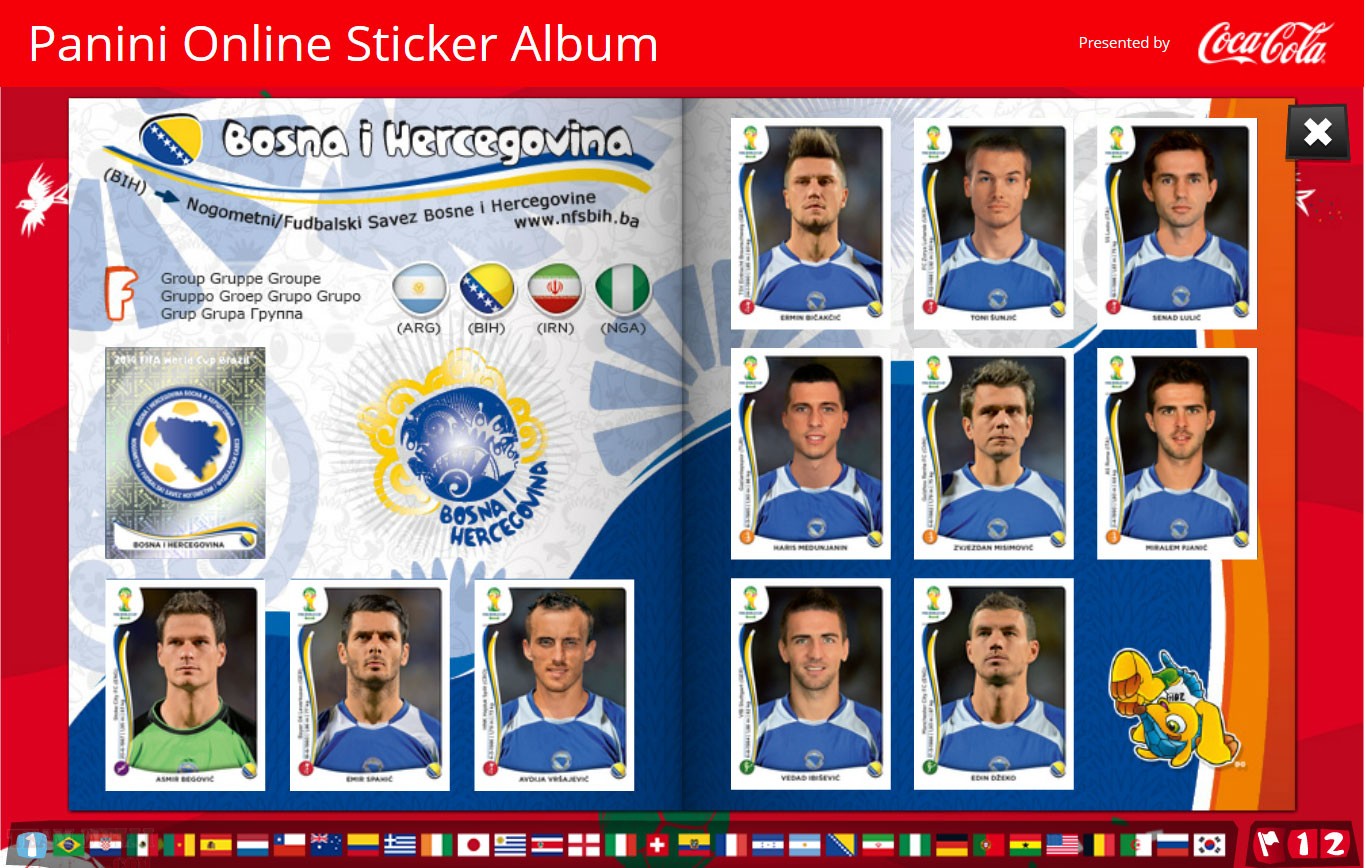
[divider]
Official list of Iran
Goalkeepers (3)

1) Rahman Ahmadi – Sepahan Esfahan (Iran)
[divider]

22) Daniel Davari – Grasshoppers (Switzerland)
[divider]

12) Alireza Haghighi – FC (Portugal)
[divider]
Defenders (9):

13) Hossein Mahini – Persepolis (Iran)
[divider]

20) Steven Beitashour – Vancouver Whitecaps (Canada)
[divider]

15) Pejman Montazeri – Umm Salal (Qatar)
[divider]

4) Jalal Hosseini – Persepolis (Iran)
[divider]

5) Amir-Hossein Sadeghi – Esteghlal (Iran)
[divider]

17) Ahmad Alenemeh – Naft Tehran (Iran)
[divider]

19) Hashem Beikzadeh – Esteghlal (Iran)
[divider]

23) Mehrdad Pouladi – Persepolis (Iran)
[divider]

2) Khosro Heydari – Esteghlal (Iran)
[divider]
Midfielders (8):

6) Javad Nekounam – Al Kuwiat FC (Kuwait)
[divider]

14) Andranik Teymourian – Esteghlal (Iran)
[divider]

8) Reza Haghighi – Persepolis (Iran)
[divider]

11) Ghasem Hadadifar – Zob Ahan (Iran)
[divider]

18) Bakhtiar Rahmani – Foolad Kuzestan (Iran)
[divider]

3) Ehsan Hajsafi – Sepahan (Iran)
[divider]

21) Ashkan Dejagah – Fulham (England)
[divider]

7) Masoud Shojaei – Las Palmas (Spain)
[divider]
Forwards (3):

9) Alireza Jahanbakhsh – NEC Nigemen (Netherlands)
[divider]

16) Reza Ghoochannejhad – Charlto Athletics (England)
[divider]

10) Karim Ansarifard – Tractorsazi Tabriz (iran)
[divider]
[divider]
Official list of Nigeria
Goalkeepers (3):
Vincent Enyeama –Lille FC (France)
Austin Ejide -Hapoel Be’er Sheva (Israel)
Chigozie Agbim – Gombe United (Nigeria)
Defenders (8):
Elderson Echiejile -AS Monaco (France)
Efe Ambrose – Celtic (Scotland)
Godfrey Oboabona – Rizespor (Turkey)
Azubuike Egwuekwe – Warri Wolves (Nigeria)
Kenneth Omeruo –Middlesbrough (England)
Juwon Oshaniwa – Ashdod FC (Israel)
Joseph Yobo – Norwich City (England)
Kunle Odunlami – Sunshine Stars(Nigeria)
Midfielders (6):
John Mikel Obi -Chelsea (England)
Ramon Azeez – Almeria FC (Spain)
Ogenyi Onazi –SS Lazio ( Italy)
Nnamdi Oduamadi –Varese (Italy)
Reuben Gabriel – Waasland-Beveren (Belgium)
Babatunde Michael -Volyn Lutsk (Ukraine)
Forwards (6):
Ahmed Musa – CSKA Moscow (Russia)
Shola Ameobi – Newcastle United (England)
Emmanuel Emenike -Fenerbahce (Turkey)
Peter Odemwingie -Stoke City (England)
Victor Moses -Liverpool (England)
Uche Nwofor -Heerenveen (Holland)
[/tab]
[tab title=”Venues”]
FIFA World Cup Brazil 2014 venues
[spoiler title=”Estadio Mineirao , Belo Horizonte” style=”fancy” icon=”caret-square”]
Estadio Mineirao, Belo Horizonte
Year stadium opened: 1965
Capacity: 62,547
Cost: Estimated 666 million reals ($287 million; 180 million pounds) spent on reconstruction
Stadium history: The Estadio Mineirao, which is owned by the state, has staged numerous footballing memories, having been the home of Cruzeiro. The likes of Ronaldo and Tostao have graced its turf, while it once hosted a match between Cruzeiro and Vila Nova in 1997 that was witnessed by 132,834 spectators.
Stadium trivia: The stadium has undergone a significant makeover to bring it up to modern standards, including the facilities to “capture and store up to 6,270,000 litres of rainwater,” which can be reused on site for the likes of the restrooms, while the pitch has been lowered to improve visibility for the fans.
Key fixtures: The Estadio Mineirao will host six matches at the 2014 World Cup, including one semifinal.
Snapshot: Belo Horizonte has neither the beaches of the northeast nor Rio’s pizzazz, but it has at least one redeeming feature: BH, as it is also known, has more bars per capita than any other Brazilian city. Furthermore, the local cuisine, comida mineira, is considered the best in Brazil. BH is a pleasant, if unspectacular, city, and there are some wonderful places to visit in the hills on the outskirts, such as the old colonial town of Ouro Preto and the mesmerising country park/outdoor art installation of Inhotim.
Getting there: The 6.5-mile journey to the stadium from the city centre will provide a proper matchday feel. Congested public buses or taxis will take you there — if you are lucky enough to flag an open one down. If travelling from the centre of Belo Horizonte, leave at least one and a half hours before kickoff to make sure you get there in time.
Where/what to eat: Less than three days is arguably not enough time to devote to the state of Minas Gerais’ cuisine. Mineiros love their food and rightfully so, but pao de queijo (cheese bread) aside, you’ll have to try just one dish per day to avoid serious indigestion. Leitao a pururuca (roasted young lamb), feijao a tropeira (a delicacy combining beans and vegetables) and tutu a mineira make for a fantastic meal but will probably leave you comatose for the rest of the day. Dona Lucinha (R. Padre Odorico, 38) in the city and Xapuri (Rua Mandacaru, 260) in a beautiful farm outside Belo Horizonte offer the best versions of these classics, although you’ll probably eat well in most restaurants. If you want something more cosmopolitan, Provincia di Salerno (Italian, Maranhao 18) and the amazing Oroboro (contemporary, Maranhao, 18) deliver a high standard as well.
Where/what to drink: The extremely traditional Pinguim (Grao Mongol, 157) beer house is still the best meeting point to drink cold draught beer. However, Belo Horizonte is packed with fantastic bars (botecos), some of them among the best in the country. Mineiros love their bar food (comida de boteco), so you can find excellent appetisers to complement your draught in Bartiquim (Rua Silvianopolis, 74), Redentor (Fernandes Tourinho, 500) and Patorroco (Turquesa, 865). But try any bar that takes your fancy; they are plentiful and of a good standard.
Where to stay: Savassi is an ideal neighbourhood to stay close to the most interesting eating, drinking and shopping spots. Nearby, the Lourdes and Carmo neighbourhoods are also well located and have good hotels.
Area trivia: The prolific Dada Maravilha (“There are no ugly goals; ugly is not scoring”) had more than one stint at Atletico Mineiro and scored almost 1,000 goals in his career, yet some Mineiros still say he could not play ball. Former Barcelona and AC Milan forward Ronaldinho currently plies his trade at Atletico Mineiro. Since joining the club in 2012, the Brazilian has impressed, helping the club to Copa Libertadores glory while also claiming the personal accolade that is the Bola de Ouro (Golden Ball) as a reward for his performances.
Sightseeing: If it wasn’t clear already, the best tourism you can enjoy in Belo Horizonte is closely related to food and drink. Make the most of your meals and happy hours. If you have a couple of extra days, head to the beautiful colonial city of Ouro Preto (100 kilometers away) or spend a night at the open-air museum of Inhotim (60 km away). Both are unforgettable visits.
[/spoiler]
[spoiler title=”Estadio Nacional, Brasilia” style=”fancy” icon=”caret-square”]
Estadio Nacional, Brasilia
Year stadium opened: 2012
Capacity: 68,009
Cost to build: Reportedly in excess of 980 million reals ($450 million; 280 million pounds)
Stadium history: Previously in its place was the Nacional Mane Garrincha, which opened in 1974 and was named after Brazil’s “little bird,” who helped his nation to back-to-back World Cup trophies.
Stadium trivia: The Nacional Mane Garrincha was all but demolished in 2010 to make way for the Estadio Nacional. The new version has many bells and whistles, including a lowered pitch to improve viewing for the spectators, while FIFA has been keen to talk up its environmental credentials as it aims to be carbon neutral.
Key fixtures: The stadium will host seven games at the 2014 FIFA World Cup Brazil, one of them a quarterfinal.
Snapshot: Brasilia has a modernist landscape, designed by urban planner Lucio Costa and legendary architect Oscar Niemeyer, with a mix of swooping freeways and urban zoning — there’s a restaurant sector, an embassies sector and a banking sector, with lower-income workers being forced out to the neighbouring cidades-satelites (satellite cities). What there isn’t, unfortunately, is a football sector — most of Brasilia supports one of the big teams from the southeast. But the architecture is enough to keep visitors impressed for a few days, and as the seat of government there’s no shortage of options when it comes to eating and drinking.
Getting there: It is an easy journey if you stay either in the Hotel Sector North or Hotel Sector South, which are under 4 miles away from the stadium. If you’d rather not walk, subway line 151 should take you to the stadium in a matter of 10 minutes. A taxi from the Hotel sectors should cost you about $10-15. Driving is not advised, considering the capital’s constant traffic jams.
Where/what to eat: Even though there’s not much originality in the local gastronomy, the abundance of politicians, government employees and lobbyists has brought plenty of excellent places to eat. Many of the best restaurants of Sao Paulo, Rio and Salvador have opened branches here, so if you want to go the institutional way, you won’t regret it. You will find some of them — Bargaco, Fogo de Chao, etc. — at Pontao, a beautiful jetty that overlooks the lake. However, if you want to try something less formal, check out Fred’s picadinho (Sul 405 Bloco B, Loja 10) for some tasty minced meat, a true classic of the capital. Also, you should head to 209-210 Bloco B, a street with many restaurants where creative options are available, such as Universal Diner (210, Bloco B, Loja 30), which makes for an enjoyable and satisfying (stomach-wise) evening. Indeed, Universal Diner serves fine risottos, in particular one complemented with duck.
Where/what to drink: In the aforementioned restaurant street you will also find many excellent places to raise a pint and meet locals. Chiquita Bacana (209 BI A, Loja 37), with great beer and atmosphere, is a good option. An even funkier one, Loca Como Tu Madre (306 Bloco C, Loja 36), becomes hectic by 18.00 local time, and then carries on until dinner. If you want to eat something after drinks, the legendary Beirute (109 Sul, Bloco A), a local institution, will get your energy back with delicious Arabic food.
Where to stay: Hotels are located either on the lake at Pontao (amazing views, but more isolated) or in the aptly named “Hotel Sector North” and “Hotel Sector South” (both of them almost together), where you will be much closer to most restaurants and bars — as well as the stadium.
Area trivia: The Brazilian capital is puzzling even for its natives, so it can be quite an experience for international visitors, many of whom do not know it is the centre of the country’s administrative life. Built up at the end of the 1950s as part of a project of national integration, Brasilia obeyed a rigorous urban planning that created specific sectors for housing, hotels and so forth. Hence, many streets look identical, with few landmarks to help you get your bearings. Since its inauguration in 1960, the population grew five times more than the 500,000 ideal threshold. AC Milan star Kaka was born in Gama, a district southwest of Brasilia’s centre. “Kaka lived in Brasilia for four years before leaving for Cuiaba because of his father’s job,” according to his former club Real Madrid’s official website. Gama’s rivals Brasiliense, which were formed in 2000, have Romarinho, the son of legendary forward Romario, on their books.
Sightseeing: A young city, Brasilia hasn’t got much history, but its futurist architecture, courtesy of the legendary Oscar Niemeyer, is an attraction. Public buildings such as the Brazilian National Congress and the Alvorada (the presidential palace) are both a good fit for sci-fi blockbusters and can be appreciated at surprisingly close quarters.
[/spoiler]
[spoiler title=”Arena Pantanal, Cuiaba” style=”fancy” icon=”caret-square”]
Arena Pantanal, Cuiaba
Year stadium is to be opened: 2014
Capacity: 42,968
Cost: In the region of 520 million reals ($240 million; £150 million pounds)
Stadium trivia: Built specifically for the tournament, FIFA states that “sustainability has been a central theme of the construction,” with many of the raw materials used in the process recycled, hence its nickname “The Big Green.” Its capacity will be reduced by about 10,000 once the competition has come to a close. And with local sides Mixto and Operario hardly boasting a swell of followers, there are concerns about the regularity of the stadium’s use post 2014 World Cup.
Key fixtures: The Arena Pantanal will host four group matches at the 2014 World Cup.
Snapshot: Even more contested than Manaus as a World Cup host city, Cuiaba represents both the positive and negative of Brazil’s hosting of the event. Negative because it is a relatively small, remote city with no great footballing tradition, best as its inclusion shows that the World Cup, geographically speaking at least, will be an event for all of Brazil and not just for Rio, Sao Paulo and the south. Cuiaba is not the most thrilling city on the planet, and can be feverishly hot — temperatures can reach 97 degrees Fahrenheit (36 degrees Celsius) even in June, the coldest part of the year — but it is still lively enough. The main attractions in the region lie outside the city — the incredible Pantanal wetlands, probably the best place to see exotic flora and fauna in all of South America, and the Chapada dos Guimaraes mountain range and national park.
Getting there: The stadium has a car park of 15,000 spaces, so you could certainly drive there (it is based less than 4 miles away from the city centre) or take a cab that should cost no more than $10.
Where/what to eat: There are three delicious dishes in particular that you should try: Arroz com pequi (rice with a local fruit), farofa com banana (a savoury banana dish that includes onions) and pintado (a local river fish, cooked in a variety of ways). Mahalo (Rua Presidente Castelo Branco, 359) takes some beating, serving up local, fresh ingredients via contemporary techniques. The fish rodizio at Lelis Peixaria (Rua Marechal Mascarenhas Moraes, 36) offers an all-you-can-eat flow of seafood. If you are seeking somewhere more formal, Getulio (Av. Getulio Vargas, 1147) ticks that box, while Di Pietro (Rua Joao Bento, 108) serves Italian cuisine with decent wine.
Where/what to drink: The area of Praca Popular (People Square) is an excellent spot to meet for drinks, with a high density of bars and restaurants. The recently refurbished Agua Doce (Av. Ten. Cel. Duarte, 99) and Ditado Popular (Praca Popular) offer live music from the local area, while Bar do Azeitona (Praca Popular) is always stocked with cold beer.
Where to stay: If you are looking to stay close to the bars and restaurants, then choose the historic centre of the city (Centro). If you’d rather somewhere less busy, then Goiabeiras or Miguel Sutil street would suit — rest assured the city is not large, so cab journeys are reasonably priced.
Area trivia: Local side Mixto hold the record for most state titles, having won the Campeonato Mato-Grossense on 24 occasions. Mixto are also the only club from Mato Grosso to have played at the top level of Brazilian football, the Brasileirao — in 1976 and 1986.
Sightseeing: The Mercado do Peixe (Fish Market), now known as the Museu do Rio Cuiaba (River Museum), is located on the banks of Rio Cuiaba and houses exhibitions charting in-depth information about the market’s history, as well as a restaurant serving, you guessed it, fish. Adjacent to the market is the Municipal Aquarium, which displays an impressive aquarium containing species of fish from the Pantanal area. If your budget is of a decent size, you could enquire to your hotel about taking a helicopter flight over the natural wonders of national parks Chapada and the Pantanal. If you are travelling with children, then you could visit the Federal University’s Zoo — where you can see jaguars and albino alligators — and its Indigenous Museum.
[/spoiler]
[spoiler title=”Arena da Baixada, Curitiba” style=”fancy” icon=”caret-square”]
Arena da Baixada, Curitiba
Year stadium opened: 2014 Capacity: 41,456 Cost: 220 million reals ($95 million; 60 million pounds) Stadium history: The Arena da Baixada will be the oldest venue to host matches at the tournament. Located on land once occupied by a Brazilian army depot, the stadium was built in 1914 and renovated in 1999. The Arena da Baixada is considered one of the country’s finest grounds. Stadium trivia: The upgrade to the facilities has been funded by Brazilian club Atletico Paranaense. Among the improvements are extra pitchside seats to boost attendance, but plans to have a retractable roof have been abandoned in an attempt to ensure it is ready in time for the big kickoff. In October, work at the stadium was suspended on the orders of a Brazilian labour tribunal due to safety breaches. Judge Lorena Colnago said there was “a serious risk of workers being buried, run over and of collision, falling from heights and being hit by construction material, among other serious risks.” The news has led to concerns about the ground meeting FIFA’s completion deadline of December. Key fixtures: The Arena da Baixada will host four group stage fixtures at the 2014 World Cup. Snapshot: The differences between Brazil’s regions are made clear by traveling from the heat and history of the nordeste to the chillier (at least during World Cup season) climes of the south. Not that Curitiba lacks history. The city was influenced by waves of immigration from Europe, most notably from Italy, Poland and Germany, and has a quality of life and an organised feel that is rare among Brazilian cities. There are plenty of parks and green spaces and some interesting architectural sites, including the historic central district (particularly around the Rua das Flores and the Largo da Ordem) and the Museu Oscar Niemeyer, an art museum built in the shape of an eye. Getting there: Staying around the Batel or Agua Verde neighbourhoods puts you within walking distance of the stadium, which is situated in the Batel district, in the middle of the city. There, you can take advantage of Curitiba’s impressive public transportation network, unique in Brazil and copied by several cities abroad. In any case, take your coat. It’s the coldest city among the 12 venues, with an average high for that time of year of 65 degrees Fahrenheit (18.3 degrees Celsius) and average low of 46 degrees Fahrenheit (7.8 degrees Celsius). Where/what to eat: Meat is the local delicacy, and to experience it at its most traditional you should visit Nyck Costela (Guilherme Pugsley, 1111), a low-profile option specialising in amazing ribs. Zea Mais (Barao do Rio Branco, 354) offers modern dishes in more of an upscale setting. If you’re into wine, Durski (Avenida Jaime Reis, 254) won’t disappoint, while Ernesto Ristorante (Myltho Anselmo da Silva, 1483) will satisfy even the most demanding Italian food fanatics. Where/what to drink: You might feel that the locals are more introverted than you would expect Brazilians to be, and you’ll be right. That has to do with the Curitibanos’ ancestors (mostly German and Eastern European), and it generates a more reserved atmosphere in the city. That said, several bars will make you feel welcome. Taj (Bispo Dom Jose, 2260) is a trendy venue that offers fine sushi. Vox (Rua Barao do Rio Branco, 418) is always packed and has an excellent beer and spirit selection. Where to stay: As mentioned, the Batel and Agua Verde neighbourhoods are unbeatable, as not only are they extremely close to the stadium but they also offer a wide range of hotels and restaurants and even a number of quite decent shopping malls, including the Crystal Plaza (Rua Comendador Araujo, 731) and Shopping Palladium (Av. Republica Argentina, 4121). Area trivia: Coritiba, founded in 1909, is the state’s oldest club. In October 2011, they were written into the Guinness World Records after achieving 24 consecutive victories in all competitions. Sightseeing: Such an organised city boasts an amazing network of parks. You can go from one to the next through the impressive bike paths network. The Jardim Botanico, with its beautiful Crystal Palace inside, is the best one to visit. The Crystal Palace is also a wonderful venue for shows and concerts — try to catch one if you can. The Oscar Niemeyer Museum, which is in the shape of an eye as designed by the great architect Niemeyer, is a popular destination that offers exhibitions by local artists. Also, take the Sierra Verde train through the lush green hills to the coast. Stop at Morretes for lunch and try Barreado stew — a delicious local delicacy. [/spoiler] [spoiler title=”Estadio Castelao, Fortaleza” style=”fancy” icon=”caret-square”]
Estadio Castelao, Fortaleza
Year stadium opened: 1973 Capacity: 64,846 Cost: 520 million reals ($240 million; 150 million pounds) Stadium history: The Castelao, which took four years to build before its opening in 1973, is the home to clubs Ceara and Fortaleza, which are famous for their fervent supporters. On an international level, it has been reported that the stadium once held 118,496 during a game between Brazil and Uruguay in 1980. The stadium was also the venue for Ronaldo’s long-awaited return for Brazil when they beat Yugoslavia 2-1 in 2002. Stadium trivia: The stadium’s revamp has been extensive, with upgrades including a new roof that will shelter fans from the heat and plans to improve transport links to the ground. Despite concerns about the progress being made on some grounds, the Estadio Castelao was the first of Brazil’s stadiums to be confirmed as ready for the 2014 World Cup. Key fixtures: The Estadio Castelao is to host Brazil’s second group game. Snapshot: A favourite with Brazilian tourists for its uncomplicated sun, sea and cerveja (beer) charms, Fortaleza lacks the cultural rhythms of Recife and Salvador, but is otherwise a fairly typical big nordestino city: an older downtown district, middle-class apartment buildings stretched along miles of beachfront, a friendly welcome, and the sense that a great many people are living in hardship somewhere not too far around the corner. The Arena Castelao was the first of Brazil’s World Cup stadiums to open. Away from the city, the state of Ceara has some dazzling beaches, such as Jericoacoara and Canoa Quebrada. Getting there: This is arguably the toughest of the stadiums to get to. Public buses departing from the seaside promenade at Avenida Beira Mar — which by day is ideal for a stroll and a spot of shopping at the craft shops, but by night should be treated with caution as it has a reputation for crime — as well as from the city centre, will leave you more than 1.2 miles away from the stadium, meaning a dehydrating walk under Fortaleza’s merciless sun awaits. At least you can buy water in several small shops along the way. Where/what to eat: Coco Bambu (Avenida Beira Mar 3698) offers huge portions — one serving will suffice for three — of local delicacies, including shrimp and fish cooked in coconut milk. The long-established Colher de Pau (Ana Bilhar, 1178) is the best option to savour Baiao de Dois, a traditional state of Ceara dish that uses rice and beans. And if you enjoy fresh fish, Vojnilo (Frederico Borges 409) will impress even the most demanding connoisseurs. Where/what to drink: Several bars at Avenida Beira Mar, which runs along the coast of Baia Norte, keep the atmosphere alive until late — Boteco Praia (Av. Beira Mar 1680) is a good example — although, again, be safety conscious. More centrally, Boteco Original (Av. Antonio Sales 3177) does not have the view of the waterfront but its appetisers are better. Both have a great selection of Brazilian beers, although in the state of Ceara, Antarctica is usually the coldest. Try their caipirinhas made with local fruits instead of lime. Later on, Orbita (R. Alm. Jaceguai 93) gives you an option to avoid an early night, and comes highly recommended. If you happen to be in Fortaleza on a Monday night, consider heading to El Pirata (R. dos Tabajaras 325), for what has been dubbed “the craziest place on earth on a Monday night” by the New York Times, courtesy of its nonstop music and enthusiastic attendees. Where to stay: The best hotels are concentrated in the seaside neighbourhoods — Praia Iracema, Meireles and Mucuripe — because it is the area with most security and support for tourists. Fortaleza has had its problems with violence and crime — in June 2013, Reuters reported that the wife of Brazil goalkeeper Julio Cesar was victim of an armed robbery. Area trivia: Fortaleza was a focal point at the Confederations Cup, for the right and wrong reasons. The beautiful northeastern seaside town is one of Brazil’s most popular destinations off the Rio-Sao Paulo axis and boasts the Castelao, which is arguably one of the most beautiful World Cup arenas. However, it was also the stage for battles between protesters and police when the Selecao played Mexico there in June — the clashes were particularly under the microscope because they caused a logistical nightmare that involved FIFA sponsor guests being caught in the crossfire. Nonetheless, it was at the Castelao that supporters at the stadium famously ignored FIFA’s shortened version of the Brazilian national anthem and sang it a capella — a stirring moment that became a battle cry for Neymar & Co. in the competition. In February 2012, Ceara’s club mascot “Grandpa” was banned for two home matches for making obscene gestures in a game against Ferroviario. The Grandpa mascot, complete with white beard and eyebrows, is modelled on Meton de Alencar Pinto, the club’s former president. Sightseeing: It’s a city for those who enjoy lounging by the sea, although it is also well served by huge malls, such as Iguatemi. The Meireles neighbourhood is famous for a traditional crafts fair, while Mucuripe hosts a fisherman community and a seafood market. Being a blustery place, Fortaleza is also popular with kite-surfers — Cumbuco is an amazing kite-surf beach with great atmosphere only 60km away from the city. [/spoiler] [spoiler title=”Arena Amazonia, Manaus” style=”fancy” icon=”caret-square”]
Arena Amazonia, Manaus
Year stadium is to be opened: 2013 Capacity: 42,374 Cost: Estimates range from 500 million to 600 million reals ($230-275 million, 140-170 million pounds). Stadium history: The Arena Amazonia is situated in the place of the Vivaldao stadium, which after opening in 1970 was demolished in 2011 to make way for its more futuristic successor. The biggest local side is Nacional, who were founded in 1913. Stadium trivia: The ground is located in the Amazon rain forest, making for a stunning and unique setting. Being so close to nature, consideration for the environment has been at the forefront of the stadium’s build, with a system in place so that rainwater is captured and reused to water the pitch or supply the restrooms. After the tournament has finished, the venue will, according to FIFA, host concerts and cultural events. However, reports in September claimed the venue could be used as a detention centre. Key fixtures: The Arena Amazonia will host four group stage matches at the 2014 World Cup. Snapshot: Along with Cuiaba, Manaus is most often appointed the “white elephant” of the 2014 World Cup. It is easy to see why. The best local club, Nacional, plays in Serie D and is watched by hundreds (on a good day) rather than thousands of fans, making the long-term prospects of the Arena Amazonia somewhat doubtful. But Manaus has a population of almost 2 million people, and the region represents almost 43 percent of the land mass of the country. Manaus is located in the middle of the rain forest, better served by river than road. The bustling docks area is always good fun, and the famed Teatro Amazonas (opera house), built at the height of the rubber boom, is unmissable. Boat trips up the river and into the jungle start from Manaus too. Getting there: Manaus is around 2,700 miles by road from Rio de Janeiro — and it would not be advised to travel by car as the roads in the surrounding area are not well developed. Instead, a flight to Manaus’ Eduardo Gomes International Airport is the most practical option; the journey takes four hours from Rio de Janeiro. With its location on the main avenue (Av. Constantino Nery) of the city and less than 3 miles from the old city centre, getting to the stadium should not be a problem, although beware the heat if you want to walk from your hotel as the average high temperature is 88 degrees Fahrenheit (31 degrees Celsius) with the humidity at times overwhelming. Where/what to eat: Forget barbecues and feijoada, the bean stew so famously associated to Brazil. Amazonian gastronomy will impress thanks to its access to unique ingredients. Fish (peixe) dishes are a must, given that more than 2,000 species inhabit the Amazon River (tambaqui and pacu are the most renowned varieties), but a lot of cassava-based stews are also popular. Exotic fruits like cupuacu, which tastes similar to a combination of pear and pineapple, are a treat for the untrained taste buds, while the now-mainstream superfood acai can be a refreshing alternative for the warmer times of the day. Banzeiro (Rua Teresina, 102) has a glowing reputation among locals, with the setting simple but the food and service top class. The Portuguese Alentejo (Rua Para, 555) excels with its cod dishes. Shin Surazan (Joao Valerio, 762) offers fantastic sushi with an eclectic mix of river food. Where/what to drink: Soak up the atmosphere at O Chefao (Rua Ferreira Pena, 50), where the decor is inspired by “The Godfather.” Boasting a decent beer list, O Chefao also offers excellent sharing platters of such things as cheese and beef that make for a social evening out. At Bar do Armando (Rua 10 de Julho, 593), you can drink caipirinha lime with rum while observing passers-by on the seats outside. Fresh, cold beer is also in good supply, as are the cheese and ham sandwiches. Bar do Armando, in the centre of the city, guarantees cold beer, great appetisers and a full house every night. Where to stay: The majority of the city’s accommodations is located in the urban sprawl rather than in the rain forest itself — although it is certainly possible to sleep amid the trees in one of the many lodges or pricier and plusher eco resorts. If you are feeling less adventurous, the Adrianopolis neighbourhood would be a wise bet as it is close to most of the sights. Area trivia: The now-retired Francisco Lima was born in Manaus and went on to represent a number of clubs across the globe. The defensive midfielder’s clubs included FC Zurich, Lecce, Bologna, Roma, Lokomotiv Moscow and the San Jose Earthquakes before he returned to his hometown to feature for Nacional, Rio Negro and Sao Raimundo. Sightseeing: The Arena Amazonia is located in arguably the most important city in Brazil’s Amazon region. Manaus is steeped in history, given its tales of pomp and doom following its role in the frenzy for rubber at the end of the 19th century. While the world’s biggest rain forest is undoubtedly a tourist magnet, the capital of the Amazonas state has been eager to boost its image as a modern urban centre. The Amazonas Theatre is an impressive sight, dating from Manaus’ golden age. If a concert coincides with your visit, do consider attending. If not, then perhaps take a guided tour. Meanwhile, the Mercado Municipal (Municipal Market) boasts a fine array of produce, food and souvenirs displayed in an impressive setting that has plenty of character. Adolpho Ducke’s Botanical Garden, the small but interesting Tropical Zoo and the Natural History Museum will give you a great overview regarding the biodiversity of Amazonia. Definitely put time aside for at least a one-day trip to the rain forest, while the meeting of the waters, where the Rio Negro and Amazon River combine, is a captivating phenomenon. Consult your hotel about guided tours to these attractions. [/spoiler] [spoiler title=”Estadio das Dunas, Natal” style=”fancy” icon=”caret-square”]
Estadio das Dunas, Natal
Year stadium opened: 2013 Capacity: 42,086 Cost: An exact figure is uncertain, with reports ranging from 400 million reals ($180 million, 115 million pounds) to 1 billion reals ($450 million, 280 million pounds). Stadium history: Estadio das Dunas stands on the site of the now-demolished Estadio Joao Claudio de Vasconcelos Machado, which was built in 1972 and hosted many matches between the city’s three clubs, ABC, Alecrim and America. Often referred to as the Machado, it was named after Joao Claudio Vasconcelos Machado, who was the president of the Rio Grande do Norte Football Federation and a sports broadcaster. Stadium trivia: Estadio das Dunas’ design is intended to resemble the region’s iconic sand dunes. While its capacity for the tournament will be 42,086, that figure will be dropped by 10,000 after July 13. The stadium’s shell-like structure shields spectators from the sun but keeps the ground well ventilated by the offshore breeze. Key fixtures: The stadium will host four group matches at the 2014 World Cup. Snapshot: The smallest of the northeastern cities to host the 2014 World Cup, Natal is a world away from the frenzy of Recife or Salvador. But there is no better place to go for those who like to combine their football with visits to the beach. Natal is surrounded by miles of expansive white dunes, and buggy ride operators and seafood restaurants abound. The Arena das Dunas stadium was one of Brazil’s slowest World Cup construction projects, but it seems to be back on track now. The city’s two biggest teams, America and ABC, both play in Serie B. Brazilian football’s ongoing problem with violence recently raised its ugly head in the city when seven fans were shot, two fatally, after a recent ABC night game. Such violence is gang related and highly localised and hopefully won’t affect World Cup visitors. Getting there: Major works to expand the main road to the stadium have been postponed until the 2014 World Cup has come to a close. Therefore, even though the stadium is close to the centre of the city, it is advised to leave plenty of time for your journey — up to two hours to be on the safe side. Taxis are a little more expensive than the rest of the country but are plentiful. Buses are good value but can get crowded during peak times. Where/what to eat: Rio Grande do Norte is the largest producer of shrimp in the country, so if you enjoy seafood, then definitely have your fill. It is cheap too. Camaroes Restaurante (Av. Engenheiro Roberto Freire, 2610) and Camaroes Potiguar (Rua Pedro Fonseca Filho, 8887) are situated on the Ponta Negra beach, making for beautiful surroundings as you tuck into excellent food. Mangai (Av. Amintas Barros, 3300) rarely fails to surprise tourists, with its extensive buffet that you pay for by weight. Dolce Vita (Rua Mossoro, 603) is a sophisticated Italian restaurant, while Douce France (Afonso Pena, 628) offers traditional French cuisine, including fine patisserie. For those seeking a meat fix, Fogo & Chama (Augusto Bezerra de Medeiros, 10) is a steak house with a great reputation, serving a number of different cuts. Where/what to drink: As is traditional in northern Brazilian cities, caipirinhas mixed with exotic fruits are a favourite tipple with locals. In the Capim Santo neighbourhood, Real Botequim (Shopping Cidade Jardim) serves meats and cheese to complement your drinks, while Whiskritorio (Enrico Monteiro, 1851) has a great range of spirits. In the Petropolis neighbourhood, the Choperia Petropolis (Serido, 511) is stocked with cold beer that you can drink while sitting at outside tables listening to live music. In Ponta Negra, Curva do Vento (Augusto Bezerra de Araujo, 396) provides above par pizzas and delicious stuffed potatoes. Where to stay: The majority of the accommodations is located in three regions: Ponta Negra, Coastal Highway and Centre. Ponta Negra has more bars and restaurants while hotels are easy to come by, but keep your wits about you at night as crime has been an issue. It is sensible to take a taxi after sunset. Area trivia: Of the city’s three teams, America are the only club to have reached the Brasileirao’s top division. They managed it in 2007 but lasted just one season. Two-time Brazil international Richarlyson was born in Natal. Currently playing for Atletico Mineiro where he won the Copa Libertadores in 2013, he has lifted the FIFA Club World Cup and Brazilian League (twice) with Sao Paulo. In 2007, Richarlyson was involved in a legal case when a judge commented that “football was a masculine sport, not a homosexual one” after it was alleged that the midfielder was gay. Sightseeing: The distinctive sand dunes are an obvious attraction, so be sure to enjoy the thrill of a buggy ride before unwinding on the beach; Ponta Negra, Areia Preta, Redinha and Artistas are all excellent. You should also consider a visit to the largest cashew tree in the world — covering an area of around 7,500 square meters — which is found in the district of Pirangi do Norte. The Forte dos Reis Magos (Wise Men’s Fort) will help you gain a better understanding of Natal’s history [/spoiler] [spoiler title=”Estadio Beira-Rio, Porto Alegre” style=”fancy” icon=”caret-square”]
Estadio Beira-Rio, Porto Alegre
Year stadium opened: 1969 Capacity: 48,849 Cost: Reportedly a figure in the region of 290 million reals ($130 million; 80 million pounds) on refurbishment Stadium history: Estadio Beira-Rio, nicknamed “The Giant of Beira-Rio,” is the home of club side Internacional, which are the rivals of city counterparts Gremio. In its original form, the ground took a decade to build, with fans doing their bit to aid its construction by donating raw materials, and it has since hosted a number of memorable derbies between the two Porto Alegre foes. Stadium trivia: The stadium’s new roof is considered its crowning glory, as it is both aesthetically pleasing and also laden with the latest technology — the promotional information claims it to be self-cleaning. Such innovation does not come cheap, with Internacional taking the hit by funding the reconstruction. Key fixtures: The stadium will host five matches at the 2014 World Cup, including a last 16 tie. Snapshot: The state of Rio Grande do Sul has a sense of independence from the rest of the country, similar to Texas in the United States. A World Cup visit to Porto Alegre will not be complete without drinking some chimarrao (mate tea) and feasting on some churrasco (barbecue). Rio Grande do Sul is a traditional home of Brazilian football managers (including Luiz Felipe Scolari and his predecessor as Brazil coach, Mano Menezes), and the rivalry between the two big Porto Alegre teams, Gremio and Internacional, is notoriously fierce. Both are getting new stadiums — Gremio are already playing at the impressive Arena do Gremio, and Inter will move back to their refurbished Beira Rio ground, the city’s World Cup venue, next April. Getting there: FIFA general secretary Jerome Valcke has insisted access to Estadio Beira-Rio is easy, but being next to the river Guaiba, and with some heavy traffic issues, you’d be wise to leave at least one hour early for the match if stationed in one of the recommended neighbourhoods for accommodation: Moinhos de Vento, Mont Serrat or Bela Vista. Plenty of buses will get you there, while a cab ride should cost about $20. Where/what to eat: Southerners are compulsive meat-eaters. Thanks to a few pioneering entrepreneurs, their churrasco is now well-known abroad, so you’d do well to try the real thing. The best spots are Na Brasa (Ramiro Barcelos, 389) and Bah (Diario de Noticias, 300 — Barra Shopping Sul). Besides their daily portion of red meat, the locals also enjoy more sophisticated food, and restaurants such as Del Barbiere (Jeronimo Coelho 188) and Le Bateau Ivre (Tito Livio Zambecari 805) will impress you. If you’re into wine, Rio Grande do Sul is also the source of the best wines of the country, although it is opined by some they still fall short of expectations when compared to their Argentine neighbours. One of the best Thai restaurants outside of Thailand is also in Porto Alegre. If you enjoy curry, give it a go: Koh Pee Pee (Schiller 83). Where/what to drink: The short but intense Padre Chagas street and its surroundings will keep you busy for at least a couple of days — great bars, restaurants and clubs abound. For instance, Rambla (Felix da Cunha, 977) has been a sensation since it opened in January 2013, and Z Cafe (Padre Chagas 314) is always fun. Dublin Irish Pub (Rua Padre Chagas, 342) and Mulligan Irish Pub (Rua Padre Chagas, 25) provide reasonably served Guinness, although you may wish to walk along Padre Chagas street and choose whichever bar takes your fancy — the options are plentiful Outside that region, consider a visit to Boteco Natalicio (Coronel Genuino, 217) for fantastic beer and bar food, and Lola bar de tapas (Castro Alves, 422) for a quite authentic tapas experience. Where to stay: The Moinhos de Vento neighbourhood, even if a bit upscale, is extremely well located for eating, drinking and shopping. Mont Serrat and Bela Vista are also good options. Area trivia: Right now, Luiz Felipe Scolari, who is back in charge of Brazil after leading the nation to World Cup glory in 2002, is probably the most revered coach from the Rio Grande del Sul region. Also from Porto Alegre, Dunga and Mano Menezes suffered the scorn of most Brazilians while at the helm of the national team. Sightseeing: The sunset at the Guaiba river is incredible to watch, with an amazing blend of colours as the night draws in. Watch it from a boat — one-hour tours cost about $6.5 per person — to really maximise what is a beautiful experience. The Ibere Camargo Foundation (Av. Padre Cacique, 2000) also offers a nice view of the river and shows works of an intriguing local artist together with temporary expositions. [/spoiler] [spoiler title=”Arena Pernambuco, Recife” style=”fancy” icon=”caret-square”]
Arena Pernambuco, Recife
Year stadium is to be opened: 2014 Capacity: 44,248 Cost: About 500 million reals ($230 million; £145 million pounds) Stadium history: While the stadium has been purpose-built for the tournament, the city of Recife already has hosted a World Cup match, in 1950, and a memorable one at that. Chile were the 5-2 victors over the United States at the Estadio Ilha do Retiro. Stadium trivia: Recife’s three clubs — Nautico, Santa Cruz and Sport — have passionate fan bases, and hopes are the building of a new stadium in the region will help boost the city’s economic development. Among the modern venue’s facilities is the use of solar power that will help to fuel the local area when the stadium is not in use. Key fixtures: The Arena Pernambuco will host five matches at the 2014 World Cup, including one last-16 tie. GettyImages A local dish of rice, shrimp and fejoada (red beans) Snapshot: Recife is a city not short on local pride. Whether it is in the form of Carnaval, which draws 2 million people onto the streets, or Santa Cruz, the team that has crowds of 60,000 while playing in the lower divisions, Recife is a city by the people, for the people. There likely will be no friendlier welcome for tourists in Brazil during the tournament, while the tropical beaches that surround the city will attract many visitors. Yet this is the nordeste (northeast), the culturally richest but financially poorest part of Brazil, and the huge disparity between rich and poor means crime can be an issue. That said, supporters sticking to well-policed central and tourist areas should be safe enough. Getting there: The Arena Pernambuco is located in Sao Lourenco da Mata in Recife’s metropolitan zone, about 12.5 miles from the centre of the city. You’ll have to take the subway from the city to the Cosme e Damiao station, then hop on one of the buses departing right from the outside of the station. The whole trip, if leaving from Recife’s centre, will take you at least one hour. The ground’s official website offers a “getting there” tool. Where/what to eat: Very similar to the rest of the north/northeast of the country, seafood dishes are Recife’s specialty. You should pay a visit to what the locals say is Brazil’s oldest restaurant Leite (Joaquim Nabuco, 147), as it’s a charming and traditional, though not cheap, place that serves first-rate food to the backdrop of a piano being played. Camarada Camarao (Baltazar Pereira 130) is a less formal but also entertaining venue for great seafood in the neighbourhood of Boa Viagem. Entre amigos o Bode (Marques de Valenca, 30-50) would work well if you want to try some of the local meat dishes, heavily influenced by the countryside of the state. If you like your fish a little fresher, the Taberna Japonesa Quina do Futuro (R. Xavier Marques 134) offers great sushi. Where/what to drink: As is popular in this part of the country, caipirinhas made with local fruits are a favourite. The Boa Viagem region offers a decent range of bars, such as Boteco (Boa Viagem 1600) and Guaiamum Gigante (Rua Artur Muniz 82). You can rely on both to be well-stocked with cold beer and great petiscos (appetizers). In the Pina region, the Mexican Boratcho (Av. Herculano Bandeira 513) provides food and entertainment as the nights wear on. We’d also be remiss not to mention the UK Pub (Francisco da Cunha 165), an excellent meeting point for tourists to drink stronger beers and listen to local music mixed with rock. Where to stay: The Avenida Boa Viagem is the unofficial centre of the city, replete with hotels, restaurants and shopping. Nearby, Afogados also has good hotel options — cheaper in most cases. Area trivia: There is a barbershop run by local legend Mauro Shampoo — former pro footballer turned self-taught hairdresser — whose salon, tucked away behind a strip mall, is a shrine to Recife futebol. Roger Bennett covers this topic in excellent detail here. Sightseeing: Recife is optimistically nicknamed “The Venice of the northeast” due to a couple of channels that cross the city. But other than the inviting beaches, the real interest is in beautiful Olinda, a neighbouring city with plenty of colonial buildings, some of them recently renovated, and a handful of nice bars at night. Olinda’s nightlife is slower-paced than that in central Recife, which is by no means a criticism, while it is considered relatively safe. [/spoiler] [spoiler title=”Maracana, Rio de Janeiro” style=”fancy” icon=”caret-square”]
Maracana, Rio de Janeiro
Year stadium opened: 1950 Capacity: 75,117 Cost to build: Reportedly 1 billion reals ($500 million; 322 million pounds) Stadium history: Built for the 1950 World Cup, the Maracana — infamously, so far as the home nation is concerned — hosted Brazil’s 2-1 defeat to South American rivals Uruguay in the final. The stadium — which during less regulated times was said to reach capacities of more than 200,000 — was also the venue for Pele’s 1,000th career goal, for Santos against Vasco in 1969. Stadium trivia: The famous stadium has undergone a substantial refurbishment, with all of the seats replaced and a new roof constructed — although the changes have been met with a mixed reception from those who savoured its predecessor’s history. The first game played at the newly developed Maracana, despite the ground not being fully completed, was a 2-2 draw between Brazil and England in June 2013. Regarding one of the venue’s “assets,” for those not afraid of heights, FIFA boasts: “Visitors to the stadium could watch work unfold from the Torre de Vidro [Glass Tower].” Key fixtures: Seven games will be played at the stadium, including the final. Snapshot: Rio is a place of contradictions, as the city’s poorest neighbourhoods are located side by side with its wealthiest. Against the backdrop of a beautiful natural setting, the grand ambition of the 2016 Olympics clashes with a chaotic day-to-day infrastructure and congested traffic. The beaches, tourist attractions and nightlife make Rio the New York of Brazil, at least in terms of urban energy. At the same time, as in many big Brazilian cities, crime and urban violence are often high, and though mostly concentrated in the favelas and periferia, can spill over into more affluent neighbourhoods. Getting there: The Maracana is a well-connected, if not central, stadium that is accessible by metro, train, bus or taxi. Rio’s traffic can be heavy, so if travelling by road, leave plenty of time — taking the metro or train to the stations that are both conveniently named “Maracana” makes sense. Where/what to eat: About a 15-minute walk from the stadium is Na Brasa Columbia, on the corner of Rua Haddock Lobo and Rua Afonso Pena, where you can drink beer and devour their succulent spit-roasted chicken. Away from the stadium, be sure to try one of the city’s famous Churrascarias (barbecue restaurants), such as Porcao — which has various locations — where meat lovers will be well catered for. For a little bit of history, visit Cafe Lamas (Marques de Abrantes, 18), which has been open since 1874, or the more expensive Porcao Rio’s in Flamengo (Av. Infante Dom Henrique s/n | Aterro do Flamengo). Where/what to drink: The central neighbourhood of Lapa is a warren of bars, clubs and restaurants. Carioca da Gema (Av Mem de Sa 79) offers live music, while Rio Scenarium (Rua do Lavradio, 20) and Casa Rosa (Laranjeiras | Rua Alice, 550), among many others, also offer an atmosphere that may tempt even the shyest tourists out of their chairs and onto the dance floor. If you’re in Leblon, Jobi (Avenida Ataufo de Paiva, 1166) is a diminutive boteco (Brazilian bar) that serves draught beer, which can be complemented by their excellent cod balls (bolinhos de bacalhau). Where to stay: Copacabana will lure many in, despite the neighbourhood having a reputation for being deteriorated and not particularly safe at night, meaning travel by taxi is advised. There are better options to be found elsewhere, including the neighbourhoods of Ipanema and Leblon which are calmer than Copacabana and less touristy (although no less expensive), while their counterparts like Gavea and Jardim Botanico are also easily accessible. Area trivia: Legendary duo Zico and Romario were both born in Rio, although the pair have not always seen eye-to-eye. They fell out in 1998, when it was alleged that Zico influenced manager Mario Zagallo to leave Romario out of the World Cup squad. It’s said they have since buried the hatchet. Speaking of Romario, he has a restaurant called Cafe do Gol, where the doors of the men’s toilets are decorated with caricatures of Zico and Zagallo. Sightseeing: Christ the Redeemer, while very much an obvious attraction, is a must-see ($20 per adult). The views from Corcovado mountain over the city below are stunning — it is advised you head there before midday to avoid the crowds. Tickets can be booked online. Sugar Loaf mountain, accessed via a cable car, is a little more expensive ($23 per adult), but, like the former, comes highly recommended. Tickets can be purchased from the ticket office — expect queues. The popular Copacabana is best avoided at night. If you are travelling in the area after sunset then a taxi ride is advised. Rio’s beaches have their positives and negatives, with your time spent lounging on a deckchair admiring footvolley specialists interrupted by hawkers. Keep an eye on your personal belongings no matter how relaxed you become. For those with a little more time on their hands, there are a wealth of historic towns within a day’s travel of Rio itself. Paraty, a coastal town accessible by bus, was once a key port for Brazil’s gold industry in the 17th and 18th centuries. Inland, Petropolis — which, like Paraty, is considered a largely safe place to visit — was once the sometime home of Brazilian emperors and is home to the Imperial Museum of Brazil. [/spoiler] [spoiler title=”Arena Fonte Nova, Salvador” style=”fancy” icon=”caret-square”]
Arena Fonte Nova, Salvador
Year stadium opened: 1951 Capacity: 48,747 Cost: 590 million reals ($270 million; 170 million pounds) Stadium history: This new stadium is situated in the place of the former Fonte Nova, which was the venue for several derby matches between Salvador’s Esporte Clube Bahia and Esporte Clube Vitoria, on occasion reportedly holding around 110,000 supporters. Its time came in 2007, when it was closed before being demolished three years later to make way for its successor. Stadium trivia: The Arena Fonte Nova is constructed of 45,000 square metres of concrete and has a state-of-the-art metal roof, which, for the geeky among us, is made of a “waterproof, self-cleaning and see-through membrane.” If visiting, be sure to peruse the football museum, and maybe, if your wallet needs lightening, head for the panoramic restaurant. Key fixtures: The Arena Fonte Nova will host four group matches at the 2014 World Cup, as well as a last-16 tie and a quarterfinal. Snapshot: Salvador is not short on culture. European and African influences (Salvador was the principal landing point for the slave trade) are reflected in the city’s music, literature and cuisine, while Salvador hosts one of the country’s biggest Carnaval celebrations. The city is built around the Todos os Santos bay, with the high part of the old town, the cidade alta (home to the main tourist draw, Pelourinho) overlooking the lower cidade baixa from atop a cliff. The Lacerda Elevator whisks visitors and soteropolitanos (as the locals are known) between the two. Read Jorge Amado’s Capitaes da Areia, wander around Pelourinho, watch some capoeira, visit the churches, eat acaraje, and decide whether to support Bahia or Vitoria. As Amado himself put it, “to be Baiano is a state of mind.” Getting there: Conveniently located in the centre of the city, it’s probably the easiest of the 12 stadiums to access. Jump on any of the forms of public transport to the Castro Alves square and walk less than 10 minutes to the stadium. You’ll be surprised when the Fonte Nova suddenly comes into view, looking like an alien construction in a pretty run-down area of the city. Where/what to eat: If your stomach is strong enough, you should try acaraje (mashed, fried chickpeas with shrimp) at Tabuleiro da Cira (Rua Aristides Milton) and moqueca (fish and/or shrimp cooked in palm tree oil and coconut milk) at Carangueijo De Sergipe (Av. Otavio Mangabeira, 222), with generous doses of pimenta. Otherwise, stick to the often-overcooked but healthy local fish. The most traditional moqueca places are Yemanja (Av. Otavio Mangabeira 4655) and Bargaco (Antonio da Silva Coelho 43). If you want to try something more modern, do not miss the original and delicious inventions of Amado (Av. Lafayete Coutinho 660), located at the always-effervescent Marina Pier, also a great spot to hang out at night. Where/what to drink: Baianos love their cold beer and their caipirinha, although they prefer to drink the latter with local fruits such as seriguela or umbu instead of the traditional lime. Be sure to give them a go. Their fresh, non-alcoholic fruit juices are also a must. Pereira (Rua das Hortancias, 612) in the Itaigara neighbourhood has become one of the most fashionable options to drink. Their branch next to the lighthouse in Barra is also pretty good. Later, check out any of the bars and restaurants (the Japanese Soho almost becomes a disco) at the aforementioned Marina Pier, a beautiful development by the sea.
Where to stay: You can’t go wrong with the Rio Vermelho, Graca or Barra neighbourhoods: All are popular with locals and are just a 15-minute cab away from the Fonte Nova. If you want to stay even closer to the stadium, be aware that the supply of decent hotels in the city centre is not plentiful. If you are the adventurous type, there are beautiful boutique hotels in Pelourinho and Sao Francisco, but you should be careful at night. Pick-pocketing can occur, so be sensible and take few valuables out with you. It is also advised to take a taxi at night and not to travel alone on foot. Area trivia: Vampeta — whose name is a combination of vampiro (vampire) and capeta (devil) — and Edilson are two baianos who made it big in Brazil behaving the same irreverent way during their football careers. The former has posed for G Magazine while the latter has taken part in the Brazilian version of “Dancing with the Stars.” To the desperation of neighbours Vitoria, Bahia won the national tournament in 1988, while also claiming another title from 1959 (the first Taca Brasil, in which they defeated Pele’s Santos) as the first proper Brazilian champions. Vitoria are empty-handed in national trophies, and trail Bahia in state championships 27 to 44. Sightseeing: Salvador was a major centre for the African slave trade. To gain a better understanding of the region’s history of slavery visit the Museu Afro-Brasileiro. Related to the city’s current struggles, Eduardo Alvarez wrote a piece on how Salvador’s middle- to low-income workers might struggle to afford to attend the games at Arena Fonte Nova. Pelourinho, the colonial neighbourhood, is a must-see, although you should avoid its less-crowded streets at night. If you find yourself there on a Tuesday evening, don’t miss the percussion show at Ensaio de Olodum. A picture of the Elevator Lacerda, close by, and the Mercado Modelo, where slaves were bought and sold, serve as a reminder of times gone by. If you feel like going to the beach, then the farther away from the city the better. Stella Maris, near the airport, is a good choice. Don’t miss the beautiful sunset drinking a caipirinha at Solar de Uniao — a joyous experience. [/spoiler]
[spoiler title=”Arena de Sao Paulo, Sao Paulo” style=”fancy” icon=”caret-square”]
Arena de Sao Paulo, Sao Paulo
Year stadium is to be opened: 2014
Capacity: 65,807 (including 20,000 temporary seats)
Cost to build: 820 million reals ($370 million; 230 million pounds)
Stadium trivia: After the tournament the ground will be used by Brazilian club Corinthians, which currently plays at Estadio do Pacaembu. Indeed, the decision to construct a new stadium in a city that already has three grounds has been the subject of debate.
On Nov. 27, part of the stadium collapsed, killing at least two people and causing significant damage. The venue was reported to be 94 percent complete before the tragedy, which could further delay delivery of the stadium — FIFA has set a December deadline for all 12 World Cup venues to be ready. Tim Vickery has written about how the accident highlights the need for less haste and more care ahead of the tournament.

Key fixtures: The stadium has been selected to kick off the 2014 World Cup. A semifinal will also be played there.
Snapshot: Sao Paulo can be an intimidating city, with its population of more than 20 million and landscape strewn with skyscrapers. The city is home to Brazil’s best museums, including MASP, its leading art museum, and the Museu do Futebol, tucked under the stands of the Pacaembu stadium. It is a cosmopolitan Brazilian city, with Italian (Bixiga) and Japanese (Liberdade) neighbourhoods, among others. No surprise then that Sao Paulo has an extensive range of restaurants, clubs and bars. A warning: Sao Paulo is huge and the traffic is infamous, so allow plenty of time for getting around.
Getting there: When the construction work is finished, two subway lines (3 and 11) should take you there from the centre of the city to the stadium. It is worth bearing in mind, though, that the stadium is some distance from the most interesting neighbourhoods in Sao Paulo, so allow at least one hour to get there.
Where/what to eat: For the best cheese bread in the city, head to Pao de Queijo Haddock Lobo (Rua Haddock Lobo). Warning: Attempts to eat less than three of these treats will end in failure.
Sushi aficionados would do well to head to the Liberdade district, home of Sao Paulo’s Japanese diaspora. For a few city blocks you could almost be in East Asia, with supermarkets, cafes and shops replete with Japanese staples — and kitsch manga paraphernalia.
Elsewhere, head to 348 (Miguel Caifat 348) for outstanding red meat, featuring both Brazilian and Argentine cuts, while Primo Basilico (Gabriel Monteiro da Silva 1864) offers pizza made to perfection.
Where/what to drink: The Vila Madalena neighbourhood offers the best drinking spots, from endless supplies of beer and chat (Filial, at Fidalga 254, which boasts one of the best waiters in the city, Joaquin) to an amazing gin and tonic menu (Astor at Delfina 163). There’s fantastic live music at Jazz nos Fundos (Joao Moura 1076), or Grazie Dio (Girassol 67) if you are seeking something local.
In the area on a Thursday night or Saturday afternoon? Then you’re advised to frequent the samba joint called Traco de Uniao (Claudio Soares 73).
If you are not on a tight budget, Royal (Consolacao 222) will provide you with your own waiter, but at a considerable price.
Where to stay: Jardins, Itaim or Pinheiros, near Vila Madalena, are the most interesting districts in Sao Paulo regarding shops, restaurants and nightlife, and will allow you to roam from one to another without wasting much time in traffic. Avoid Augusta (noisy) and Morumbi (too far away from the stadium).
Area trivia: The Museum of Football, located at the Pacaembu stadium, is a must for fans of the game. With collections of football shirts, futebol de botao (the Brazilian equivalent of Subbuteo) sets and plenty of interactive displays, you could easily wile away an afternoon here.
Legendary right-back Cafu was born in Sao Paolo, and went on to make more than 100 appearances for the Tricolor and helping them win a number of trophies. Cafu made 142 appearances for Brazil, appearing at three consecutive World Cups, lifting the title twice.
Sightseeing: Two skyscrapers offer staggering views of Sao Paulo’s concrete jungle. The Banespa building (Joao Bricola 24) is the more popular of the pair, meaning there can be queues during busy periods. Edificio Italia (Ipiranga 344), meanwhile, is usually quieter, with many people unaware that there is a viewing platform (with no real safety barrier, incidentally) one floor above a swanky restaurant. You have to pay, but the panorama is worth it.
For something a little obscure, head to the Butantan Institute to watch snakes being milked for their venom once a day.
[/spoiler]
[/tab]
[tab title=”Squad”]
Team Melli Squad – FIFA World Cup Brazil 2014
| Shirt Number | Player Name | |
|---|---|---|
3 | HAJi SAFi, Ehsan25-Feb-90 23 years Sepahan Defender 60 Caps 3 Goals | 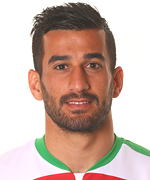 |
4 | HOSSEINI, Jalal03-Feb-82 31 Years Persepolis Defender 86 Caps 6 goals | 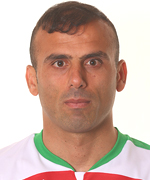 |
6 | NEKOUNAM, Javad06-Sep-80 33 Years Al Kuwait FC (KWI) Midfield 143 Caps 37 Goals | 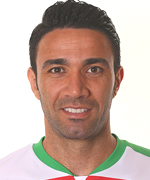 |
14 | TEYMOURIAN, Andranik06-Mar-83 30 Years Esteghlal Midfield 79 Caps 9 Goals | 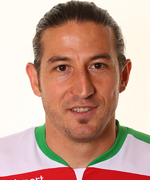 |
10 | ANSARIFARD, Karim03-Apr-90 23 Years Tractorsazi Forward 42 Caps 9 Goals | 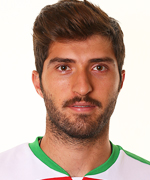 |
7 | SHOJAEI, Masoud09-Jun-84 29 Years Las Palmas (ESP) Midfield 51 Caps 5 Goals | 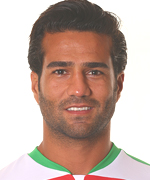 |
1 | AHMADI, Rahman30-July-80 33 years Sepahan Esfahan Goalkeeper 11 Caps | 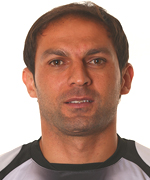 |
21 | DEJAGAH, Ashkan05-Jul-86 27 years Fulham (ENG) Midfield 14 Caps 4 Goals | 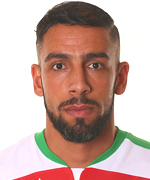 |
20 | BEITASHOUR, Steven01-Feb-1987 26 years Vancouver Whitecaps (CAN) Defender 6 Caps | 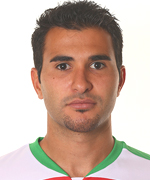 |
22 | DAVARI, Daniel06-Jan-88 25 years Grasshopper (SWI) Goalkeeper 4 Caps | 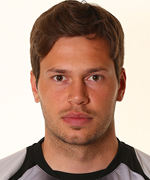 |
16 | GHOOCHANNEJAD, Reza20-Sep-87 26 years Charlton Athletics (ENG) Forward 14 Caps 10 Goals | 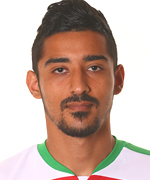 |
13 | MAHINI, Hossein16-Sep-86 27 years Persepolis Defender 23 Caps | 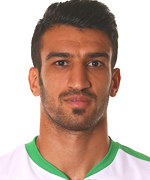 |
15 | MONTAZERI, Pejman09-Sep-83 30 years Um Salal (QAT) Defender 22 Caps 1 Goal | 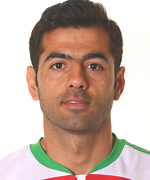 |
9 | JAHANBAKSH, Alireza08-Oct-93 20 years NEC Nijmegen (NED) Forward 7 Caps 1 Goal | 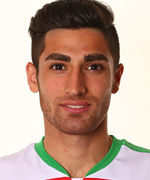 |
5 | SADEGHI, AmirHossein06-Sep-81 32 years Esteghlal Defender 15 Caps 1 Goal | 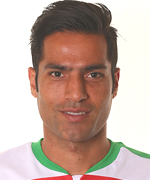 |
8 | HAGHIGHI, Reza31-Jan-1989 24 years Persepolis Midfield 9 Caps | 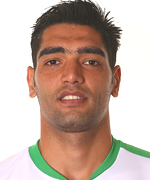 |
11 | HADDADIFAR, Ghassim12-Jul-83 30 years Zob Ahan Midfield 18 Caps | 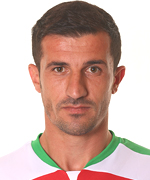 |
23 | POOLADI, Mehrdad20-Feb-87 26 years Persepolis Defender 21 caps | 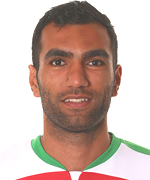 |
19 | BEIKZADEH, Hashim22-Jan-84 30 years Esteghlal Defender 16 caps 1 goal | 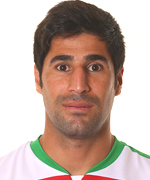 |
17 | ALE NEMEH, Ahmad20-Oct-82 32 years Naft Tehran Defender 9 caps 1 goal | 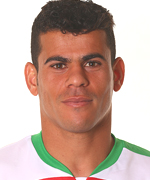 |
12 | HAGHIGHI, Alireza02-May-88 26 years Sporting Covilhã (POR) Goalkeeper 6 caps | 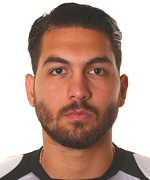 |
2 | HEYDARI, Khosro14-Sep-83 30 Years Esteghlal Defender 49 Caps | 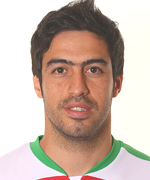 |
18 | RAHMANI, Bakhtiyar23-Sep-91 23 Years Foolad Khuzestan Midfield 7 Caps | 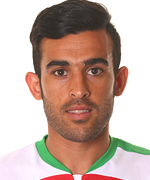 |
QUEIROZ, Carlos01-Mar-53 61 Years Head Coach | 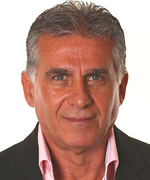 |
[/tab]
[tab title=”Matches”]
Team Melli Matches- FIFA World Cup Brazil 2014
Maracanã – Estádio Jornalista Mário Filho Rio De Janeiro (BRA)




Estadio Mineirao Belo Horizonte (BRA)


Arena Pantanal Cuiaba (BRA)


Estadio Beira-Rio Porto Alegre (BRA)


Arena Fonte Nova Salvador (BRA)


[/tab]
[tab title=”Stats”]
TEAM MELLI PLAYERS’ STATISTICS
Shirt # | Player Name | Matches | Minutes | Goals | YC | RC |
|
|---|---|---|---|---|---|---|---|
1 | AHMADI, Rahman30-July-80 33 years Sepahan Esfahan Goalkeeper 11 Caps | 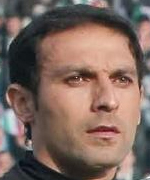 | |||||
2 | HEYDARI, Khosrow14-Sep-83 30 Years Esteghlal Defender 49 Caps |  | 1 | 89 | |||
3 | HAJSAFY, Ehsan25-Feb-90 23 years Sepahan Defender 60 Caps 3 Goals |  | 1 | 90 | |||
4 | HOSSEINI, Jalal03-Feb-82 31 Years Persepolis Defender 86 Caps 6 goals | 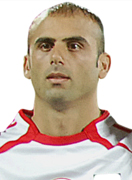 | 1 | 90 | |||
5 | SADEGHI, AmirHossein06-Sep-81 32 years Esteghlal Defender 15 Caps 1 Goal | 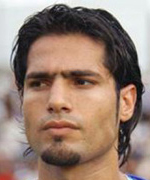 | 1 | 90 | |||
6 | NEKOUNAM, Javad06-Sep-80 33 Years Al Kuwait FC (KWI) Midfield 143 Caps 37 Goals |  | 1 | 90 | |||
7 | SHOJAEI, Masoud09-Jun-84 29 Years Las Palmas (ESP) Midfield 51 Caps 5 Goals |  | 1 | 1 | |||
8 | HAGHIGHI, Reza31-Jan-1989 24 years Persepolis Midfield 9 Caps |  | |||||
9 | JAHANBAKSH, Alireza08-Oct-93 20 years NEC Nijmegen (NED) Forward 7 Caps 1 Goal | 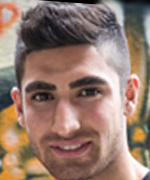 | 1 | 12 | |||
10 | ANSARIFARD, Karim03-Apr-90 23 Years Tractorsazi Forward 42 Caps 9 Goals |  | |||||
11 | HADDADIFAR, Ghassim12-Jul-83 30 years Zob Ahan Midfield 18 Caps |  | |||||
12 | HAGHIGHI, Alireza02-May-88 26 years Sporting Covilhã (POR) Goalkeeper 6 caps | 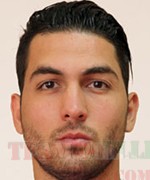 | 1 | 90 | |||
13 | MAHINI, Hossein16-Sep-86 27 years Persepolis Defender 23 Caps | 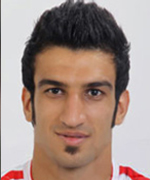 | |||||
14 | TEYMOURIAN, Andranik06-Mar-83 30 Years Esteghlal Midfield 79 Caps 9 Goals | 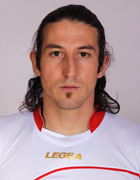 | 1 | 90 | 1 | ||
15 | MONTAZERI, Pejman09-Sep-83 30 years Um Salal (QAT) Defender 22 Caps 1 Goal | 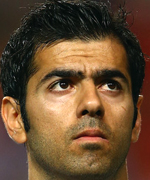 | 1 | 90 | |||
16 | GHOOCHANNEJAD, Reza20-Sep-87 26 years Charlton Athletics (ENG) Forward 14 Caps 10 Goals | 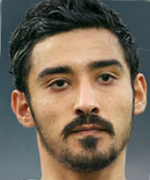 | 1 | 90 | |||
17 | ALE NEMEH, Ahmad20-Oct-82 32 years Naft Tehran Defender 9 caps 1 goal |  | |||||
18 | RAHMANI, Bakhtiyar23-Sep-91 23 Years Foolad Khuzestan Midfield 7 Caps |  | |||||
19 | BEIGZADEH, Hashim22-Jan-84 30 years Esteghlal Defender 16 caps 1 goal |  | |||||
20 | BEITASHOUR, Steven01-Feb-1987 26 years Vancouver Whitecaps (CAN) Defender 6 Caps | 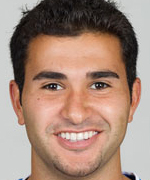 | |||||
21 | DEJAGAH, Ashkan05-Jul-86 27 years Fulham (ENG) Midfield 14 Caps 4 Goals |  | 1 | 78 | |||
22 | DAVARI, Daniel06-Jan-88 25 years Grasshopper (SWI) Goalkeeper 4 Caps | 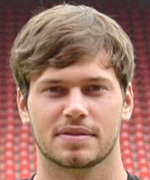 | |||||
23 | POOLADI, Mehrdad20-Feb-87 26 years Persepolis Defender 21 caps |  | 1 | 90 |
[/tab]
[/tabs]

